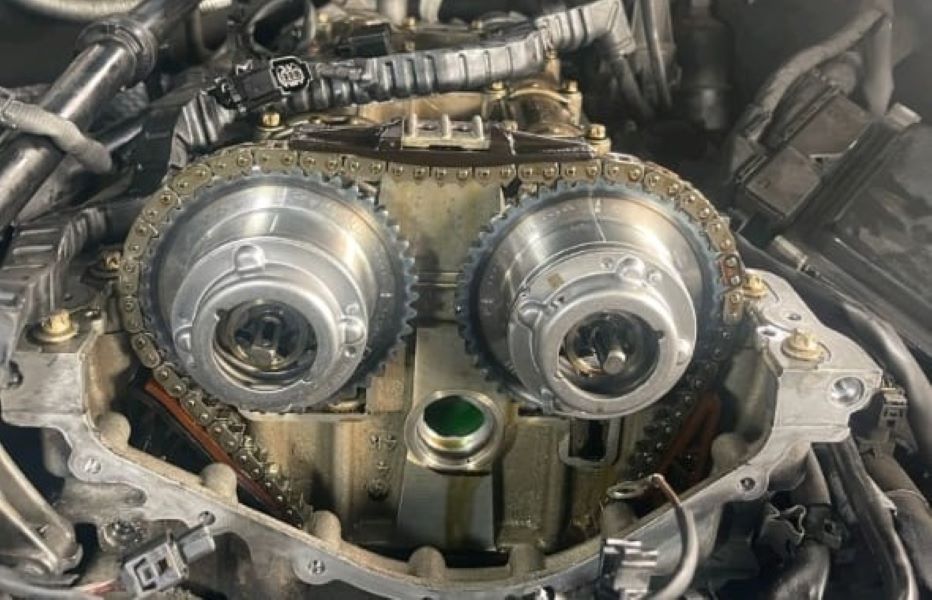Table of Contents
Long Cranking Before Start in Mercedes-Benz E-Class W212: Causes, Fix & Case Study
If your Mercedes-Benz E-Class takes longer than usual to start, especially after sitting overnight or during cold weather, you may be dealing with a long cranking before start issue.
This article explores a real-world case study of a Mercedes-Benz E Class W212 equipped with the M271 engine, explaining the diagnostic process, the root cause (camshaft timing misalignment), and the repair steps that restored smooth engine operation.

Customer Complaint
Vehicle: Mercedes-Benz E-Class (W212)
Engine: M271
Reported symptoms:
- – Long cranking before the engine starts
- – Check Engine Light (CEL) illuminated
- – Noticeable misfiring during cold start
These symptoms pointed toward a possible timing or synchronization issue rather than a simple electrical or fuel fault.
Diagnostic Overview
When diagnosing a long cranking condition, technicians begin by verifying the following:
- – Starter motor and battery voltage
- – Fuel delivery and injector pulse
- – Ignition and timing synchronization
In this case, the diagnostic scan results provided the first major clue.
1. Fault Code Identification
Using Mercedes XENTRY Diagnostics, the following error codes were retrieved:
| Code | Description |
|---|---|
| P0011 | Camshaft position (intake) timing over-advanced |
| P0014 | Camshaft position (exhaust) timing over-advanced |
| P0300 | Random/multiple cylinder misfire detected |
These codes suggested incorrect camshaft timing, which can directly cause long cranking, misfire on cold start, and CEL illumination.
2. Camshaft Position Analysis
A live comparison between actual and desired camshaft positions revealed a slight deviation indicating that the camshaft sprocket tension was weak, preventing accurate synchronization.
This was confirmed by reading “actual values” in the diagnostic data a standard method used to check timing consistency on M271 engines.
Investigative Procedure
3. Visual Inspection (Tappet Cover Removal)
To confirm the timing fault, the tappet cover was removed.
The inspection revealed:
- – Misaligned cam sprocket timing marks
- – Slack tension in both intake and exhaust cam sprockets
This confirmed that mechanical wear was affecting the variable camshaft system, leading to delayed ignition timing and long cranking.
Tip: When diagnosing similar issues, always inspect the camshaft sprocket and chain tensioner after verifying electrical and sensor data.

Root Cause
The weakened cam sprocket tension disrupted the synchronization between the intake and exhaust camshafts, causing:
- – Prolonged cranking before start
- – Cold start misfires
- – Check Engine Light activation due to cam position sensor correlation errors

Repair Process
5. Cam Sprocket Replacement
To restore proper timing, both cam sprockets were replaced following OEM procedures:
| Component | Action Taken |
|---|---|
| Intake cam sprocket | Replaced with OEM part |
| Exhaust cam sprocket | Replaced with OEM part |
| Timing alignment | Verified using Mercedes WIS timing marks |
After installation:
- – The tappet cover was refitted.
- – Engine oil level was verified.
- – Diagnostic adaptation was reset using STAR Diagnosis.


6. Post-Repair Testing
| Test | Result |
|---|---|
| Cold start test | Engine started immediately |
| CEL (Check Engine Light) | Cleared, no return after multiple cycles |
| Camshaft synchronization | Perfect alignment confirmed via diagnostic data |
The long cranking issue was resolved, and the engine started smoothly without hesitation during subsequent cold starts.
Diagnostic Summary
| Step | Tool / Action | Finding | Conclusion |
|---|---|---|---|
| Fault code check | XENTRY Diagnostics | Camshaft timing & misfire codes | Timing deviation confirmed |
| Actual vs desired values | Live data | Cam positions out of sync | Cam sprocket tension weak |
| Visual inspection | Tappet cover removed | Misaligned timing marks | Mechanical issue found |
| Repair | Replace cam sprockets | Correct timing restored | Smooth start achieved |
Why Timing Issues Cause Long Cranking
When the camshaft and crankshaft are even slightly out of sync:
- – The ECU receives conflicting position signals.
- – Fuel injection and ignition timing are delayed.
- – The engine cranks longer to find the correct synchronization point.
On the M271 engine, this is often caused by:
- – Worn camshaft sprockets
- – Weak chain tensioners
- – Stretched timing chains
Prevention Tips
| Maintenance Action | Recommended Interval / Advice |
|---|---|
| Replace camshaft sprockets / chain tensioner | Every 100,000–120,000 km or when noise occurs |
| Use only OEM oil filters and approved oil | Prevents hydraulic tensioner failure |
| Regular diagnostic scans (Service A / B) | Detects timing deviations early |
| Avoid low oil pressure during cold starts | Maintains chain lubrication and tension |
Related Diagnostic Resource
If you’re facing similar starting problems, explore our full troubleshooting hub:
Mercedes No Start Issues: Causes, Fixes & Case Studies : a complete guide covering electrical, fuel, and ECU-related no-start scenarios across multiple Mercedes models.
FAQ: Long Cranking Before Start
1. What causes long cranking in Mercedes engines?
Common causes include weak camshaft sprockets, low fuel pressure, or poor sensor synchronization between crankshaft and camshaft.
2. Can camshaft sprockets cause misfires?
Yes. Incorrect timing affects valve operation, leading to misfires and inefficient combustion during cold starts.
3. How do I confirm camshaft timing issues?
Compare actual vs desired camshaft positions using XENTRY. A consistent offset indicates timing deviation.
4. Is this repair expensive?
Replacing both sprockets and resetting timing typically costs less than replacing a full timing chain assembly, but OEM parts are essential.
Author Bio
Written by Mercedes Expert
With years of hands-on experience diagnosing and repairing Mercedes-Benz systems, he brings technical depth and practical case studies to help car owners, technicians, and enthusiasts troubleshoot complex automotive issues. His work focuses on clear repair guides, OEM-level procedures, and knowledge-sharing to empower both professionals and drivers.
Last update: October 2025






Leave a Reply